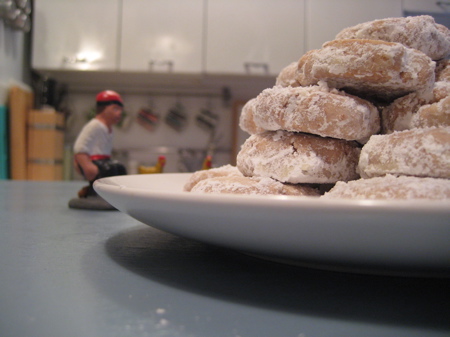
Teresa Parker blogs about restaurants, recipes, and the reasons why she's in love with Spain's food and culture.
 Although "cookies" have recently appeared in a few modern-chic pastry shops in Barcelona and Madrid, there is not really any equivalent of the American Christmas cookie tradition in Spain. For one thing, let's face it: cookies are lumpy, loving-hands-from-home things and Spaniards are uptight about that kind of homeliness. They prefer to entrust their sweet endings to fancy pastry shops where they can count on perfect discs of mousse-filled genoises with glossy-gold caramelized sugar glazes. Besides, except in the cooler, cow-studded, mountainous north, people just don't have a lot of butter lying around the house here. What they do have is manteca. Lard. Yes, from pigs. My ex was Andalusian, so even though we lived in Barcelona, his mother always laid in a supply of mantecados -- a crumbly shortbread made with lard and ground almonds -- for Christmas. Polvorones too: they're a more nutty, less floury formulation of the mantecado. They came from Estepa, delivered by visiting Sevillano friends. The story goes that mantecados were perfected some 150 years ago by a famously large woman known as "La Colchona" (translation: "The Mattress") who baked them for her husband to sell along his pony express-style transport route from Estepa to Córdoba. Nuns in Southern Spain still crank out tons of these sandy sweets for the holidays (keeping cloistered, perhaps, for fear of nicknames). Mantecados come individually wrapped in crinkly thin paper and dusted with powdered sugar. When you unwrap them you get only the faintest whiff of almond or cinnamon or lemon or anise seed -- the classic sweet-enhancing flavors of Spain. You have to nibble carefully or the whole cookie just dissolves into a pile of crumbs in your hand. Joaquín always advocated squeezing the whole thing into a ball before unwrapping it, and felt it was crucial to pop it into his mouth all at once. If you're in Barcelona and missing Southern Spain's mantecados, head for Caelum, a shop full of sweets supplied by convents and monasteries (C/ Palla 8 at the corner of Carrer del Pi, Tel: 93-302-69-93). If you're in the U.S., I know you're tempted to slip on your wimple and start baking, but you're probably afraid to go for the lard. So here's my butter-based interpretation. This is an easy cookie of few ingredients, humble, crumbly-dry, not too sweet, meant to keep company with a good café solo or licor.
Although "cookies" have recently appeared in a few modern-chic pastry shops in Barcelona and Madrid, there is not really any equivalent of the American Christmas cookie tradition in Spain. For one thing, let's face it: cookies are lumpy, loving-hands-from-home things and Spaniards are uptight about that kind of homeliness. They prefer to entrust their sweet endings to fancy pastry shops where they can count on perfect discs of mousse-filled genoises with glossy-gold caramelized sugar glazes. Besides, except in the cooler, cow-studded, mountainous north, people just don't have a lot of butter lying around the house here. What they do have is manteca. Lard. Yes, from pigs. My ex was Andalusian, so even though we lived in Barcelona, his mother always laid in a supply of mantecados -- a crumbly shortbread made with lard and ground almonds -- for Christmas. Polvorones too: they're a more nutty, less floury formulation of the mantecado. They came from Estepa, delivered by visiting Sevillano friends. The story goes that mantecados were perfected some 150 years ago by a famously large woman known as "La Colchona" (translation: "The Mattress") who baked them for her husband to sell along his pony express-style transport route from Estepa to Córdoba. Nuns in Southern Spain still crank out tons of these sandy sweets for the holidays (keeping cloistered, perhaps, for fear of nicknames). Mantecados come individually wrapped in crinkly thin paper and dusted with powdered sugar. When you unwrap them you get only the faintest whiff of almond or cinnamon or lemon or anise seed -- the classic sweet-enhancing flavors of Spain. You have to nibble carefully or the whole cookie just dissolves into a pile of crumbs in your hand. Joaquín always advocated squeezing the whole thing into a ball before unwrapping it, and felt it was crucial to pop it into his mouth all at once. If you're in Barcelona and missing Southern Spain's mantecados, head for Caelum, a shop full of sweets supplied by convents and monasteries (C/ Palla 8 at the corner of Carrer del Pi, Tel: 93-302-69-93). If you're in the U.S., I know you're tempted to slip on your wimple and start baking, but you're probably afraid to go for the lard. So here's my butter-based interpretation. This is an easy cookie of few ingredients, humble, crumbly-dry, not too sweet, meant to keep company with a good café solo or licor. Cinnamon Almond Mantecados
Makes 30 cookies
3 oz. whole raw almonds (a steeply heaping 1/2 C)
5 Tbsp. confectioners' sugar (plus 1/2 C for rolling the finished cookies)
1 tsp. cinnamon (or a Tbsp. or so anise liqueur, or a few drops lemon essence)
1 cup all purpose flour
a fat pinch of salt
1/4 lb. (one stick) butter
Preheat oven to 350F. Put almonds on a baking sheet and toast them, about 10 minutes. Give them a stir after 5 minutes and take them out if they're very toasty, you don't want them to burn... but in my oven they need another 5 to get a bit darker and aromatic. Let them cool completely. I don't bother to skin them; the ground skin makes the cookie more flavorful and rustic.
Whirl almonds, the 5 Tbsp. confectioners' sugar, cinnamon, and salt in a food processor. Process until almonds are finely ground. Add the flour and pulse again. Add the butter and pulse the processor until the dough holds together -- it will be crumbly.
(At this point I like to take the blade out of the processor, clean it, and get it put away somewhere safe. That way you can work right out of the processor bowl without losing any fingers.)
Gently roll dough in your hand to make small balls about 1-inch in diameter (or 1/2 oz each). Place on cookie sheet -- they can all go on one sheet, they do not spread much. Using the bottom of a glass dipped in confectioners' sugar to prevent the dough from sticking, squash each ball slightly, leaving the rounds quite thick.
[NOTE: The originally posted recipe was short of flour. I've corrected it: should be one cup. In re-working the recipe, I tried a different way of shaping the cookies and I love the results... If you want something more like what the nuns cookies look like, do this: shaped the dough into a couple of logs 1 and 1/4 inch in diameter and sliced them 1/2 inch thick. The dough is very crumbly and doesn't want to make a neat roll, so that's why even for this small recipe, I made two rolls: they're easier to manage. I formed the roll on a sheet of plastic wrap and rolled it around the dough to help me shape and gently squeeze it into a neat round. No need to refrigerate before slicing and baking.]
Bake 10 to 12 minutes. They should be firming up a bit but not browning at all. Cool a few minutes on the cookie sheet, then remove and cool a bit more on a rack. Roll in the remaining 1/2 C confectioners' sugar while they're still a little warm and continue to cool before eating. Or storing. If you're feeling saintly wrap them in little waxed paper squares.

Comments
teresa replied on Permalink
Judi, Hooray for rendering your own lard. Would you be willing to describe that here?
After your question and Mac's I've re-tested the recipe and added flour. The correct amount is one cup. Then yes, the recipe does make thirty cookies: they're small, 1/2 oz balls, about one inch in diameter, a bit bigger when flattened slightly.
About the flour and toasty flavors: The toastiness is part of what makes these cookies a little different from my "Mexican Tea" cookie recipes. While some Spanish bakers toast the flour slightly (in the oven on a baking pan or in a skillet), I'm just as happy with the plain flour -- I do let the almonds get nice and toasty, a full shade darker, though being careful not to let them burn. I keep the skins on, too.
judi replied on Permalink
I recently rendered my own lard for the first time and would love to try this recipe using it, but I can't believe that ingredients listed really make thirty cookies. All the recipes I've found on the web are so different from one another. Some of them sound exactly like what we call Biscochitos here in New Mexico. Thanks.
teresa replied on Permalink
Mac, I'm so glad you made these... and the anise flavored version too (I love you even more than ever now). I'm thinking maybe the liquid version of anís or Pernod really dissolves the powdered sugar quickly -- you know how those old icing recipes work where the cream quickly turns a bowl full of confectioners' sugar into a little bit of icing? That must be why matalauga or anis seed is more commonly used.
Rosa replied on Permalink
Teresa, these look amazing. I'm inspired to bake them as Christmas gifts!
mac replied on Permalink
Hi Teresa!
I gave these a whirl and had an interesting time using the butter, which I may have had a bit too soft. It seemed that my dough was way to wet so I added some flour. I also used Pernod, which gave it that great anise flavor, which may have added to the wetness as well.
The flavor is fantastic, but they came out more like an anise flavored sugar cookie. Still delightful, but can I still call them "Mantecados"?
Happy holiday cheer!!
mac
Brandi replied on Permalink
Thank you so much for posting this recipe! I lived in Madrid for two months while studying abroad and fell in love with these. Of course I can't find them in the US so thank you for posting, I can't wait to make them!